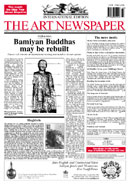|
Nina Siegal

WEATHER






|
(Anti-Greenbergian Sour Grapes)
A synopsis of talking points from a very bad review in the New Republic of the John Currin mid-career retrospective which opened at the Whitney Museum of American Art in November
The New Republic
JED PERL ON ART
Beyond Belief
-
mousy imitations of old-master portrait styles would not earn him a freelance gig as a magazine illustrator
-
Currin is a symptom. He reflects the cracked values of an art world where most of the people in charge no longer know what gives a work of art life.
- lounge lizard gambits are hailed for giving classical values a modern ironic twist
-
dabbles with misogyny, but slyly, so that it registers as nouveau masculinity.
-
art world's equivalent of the fast-talking politician
-
prime-time buffoon
-
the poverty-stricken girls who painted flowers on porcelain plates in nineteenth-century French factories were more talented than he is
- work is toxic--art pollution
-
a confetti shower of doubletalk and disinformation
-
heralded as an original when he embraces such hackneyed late modern gambits as the Courtesy Whitney Museum of American Art return to painting, the revival of portraiture, ironic traditionalism, and tongue-in-cheek social commentary
-
almost nobody in the press questions Currin's alleged importance--certainly not The New York Times, which has more and more become a cheerleading section for whatever the museums choose to do about contemporary art
-
glassy surfaces, weird passages of impastoed paint, fakey feathery brushwork, and violations of anatomy, which may be conscious stylizations but are more likely signs of plain incompetence
-
the people who put him where he is and mean to keep him there--believe that trash is transcendent
-
began with the unctuous nudes that Francis Picabia painted from photographs of pinups in the 1940s. Since the 1980s, those seedy compositions have been the subject of an intellectual game in which bad painting is turned into good painting, which in turn is represented as something bad, and so forth, until the very idea of taste becomes a sick joke
-
You can give the canvas a workout and still be a stinko technician
-
Currin's supporters, and they are the same people who have pitched for Lichtenstein and Schnabel and Koons, have moved beyond belief
-
I wonder if there is any longer a chance of rescuing the serious critique of modernism from a postmodernism that hides its cynicism beneath a veneer of traditionalist good manners, as in Currin's work
-
the interesting question is not why Currin's paintings are so bad but why he is so successful
-
not a healthy playfulness about values but a wholesale derangement of values
-
not the first time in history that there has been a wildly inflated market for meretricious art
-
the taste for trash is a kind of free-floating prurience that embraces fashion magazine photography, afternoon soap opera sentimentality, the va-va-voom proportions of Vargas girls pinups, the slick graphic tricks promoted by mail-order learn-to-draw programs, the sensuous tug of pictorial illusionism, the pretensions of the art audience, and the overloaded emotionalism of old master paintings
-
sour eclecticism
-
John Currin, with his studiously inept mix of Cranach (the Elder) and the Cosmo girl, is "meta-trash" triumphant
|
|